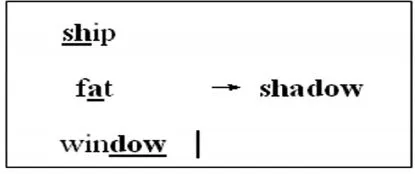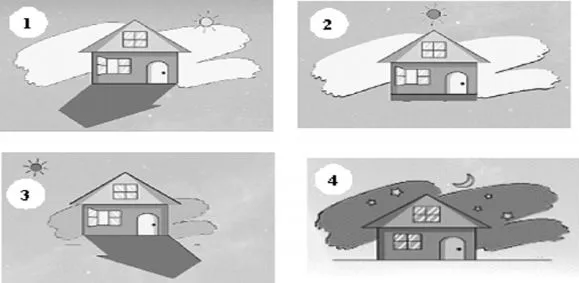沪教版《牛津英语》四(下)Module 1 Unit 3 Look and see
郭伟华
教学过程
Step 1.Lead-in
T:In previous classes,we learned our that we have five senses.We can touch and feel with our hands.We can smell with our nose.We can taste with our mouth.We can also look and see with our eyes.
Today, we will go on learning Unit 3“Look and see”.Together let’s find outhow beautiful our world is with our eyes.
【设计意图】从本模块“five senses”话题入手,以第一、二单元学过的有关触觉、嗅觉和味觉的单词导入到本单元视觉类单词的学习,承上启下,激发学生学习的兴趣。
Step 2.Preparation
1.New Words(单词学习)
a.shadow影子
T:(做手影)Look!What can you see?
A bird.How about this?A cat.Is it a real cat?

Ss:No.是影子。
T:How to say“影子”in English?

【设计意图】表演手影,让学生直观感受到影子,提高学习单词的兴趣。引导学生从已学的单词中发现shadow的发音,培养自学能力。
b.rise升起,go down落下
T:为什么会有影子?
S1:因为有光。
T:白天我们在户外能看到影子是因为有什么?
S2:太阳。The sun.
T:Here is the sun(太阳的图片).This is a mountain(大山的简笔画).早上太阳从东方升起,中午升到天空的最高处,傍晚太阳从西方落下。rise表示“升起”,go down就表示“落下”。The girl,stand up please.这个起身的动作,也叫rise。
【设计意图】通过太阳升起、落下的动作,让学生直观感受到单词“rise,go down”的意思。通过让一个学生起立的动作,拓展rise的释义。
2.Sentences
请学生上台,利用图片模拟太阳相对于大山的运行轨迹。
T:Look at the blackboard.Let’s describe the sun’s movement.
Ss:The sun rises.The sun goes down.
【设计意图】利用图片,演示太阳升起落下,创设情境后,再给出句子,提高学生学习的积极性。
T:How about the moon?
How about the stars?
Ss:The moon rises.
The moon goes down.
The stars rise.
The stars go down.
T:大家可以看到,描述太阳和月亮的升起用的是rises,落下用的是goes down,描述星星用的却是rise和go down。Why?
【设计意图】引导学生对比“太阳、月亮和星星的升起落下”动词运用的差异,引导学生发现一般现在时中动词单三形态的用法。
3.Grammar
T:我们知道太阳的升起和落下是自然现象,这里我们用到的是一般现在时。这样我们就找到了规律:一般现在时中,当主语是第三人称单数时,句子中动词的词尾要变化。
既然单三后动词的词尾需要变化,那么如何变化?通过导学案“Level 1”闯关游戏,自己找出规律。

(2)Peter does his homework at night.
The sun goes down in the evening.
→以o结尾的动词加____
(3)She has a white dress.
PeterhasanorangeT-shirt.
→have的第三人称单数形式为________
小组讨论规律并展示。
【设计意图】通过完成导学案“Level 1”,引导学生发现一般现在时中动词第三人称单数的变化规律。
Step 3.Presentation
1.给出四幅图,让学生根据太阳和月亮的位置来判断出时间 :morning,noon,evening,night


2.引导学生描述图中太阳、月亮的位置。通过唱《小星星》让学生回忆“high”和“in the sky”的表达法。
In themorning,thesun rises.
At noon,the sun is high in the sky.
In the evening,the sun goes down.
At night,the moon is high in the sky.
【设计意图】分图讲解,降低课文的难度,帮助学生理解。
3.T:Look,The torch is the sun.This is a tree.Look at its shadow.
T&Ss:In the morning,the shadow is long.At noon,the shadow is short.In the evening,the shadow is long again.
【设计意图】用手电筒和树让学生真实地观察树影的变化,为接下来文中房子影子变化的学习做好铺垫。
4.让学生观察图中房子影子的变化,并引导学生描述。
T:In the evening,look at the shadow.It is long again.
again表示“又,再”。OK! Read the sentence.Once again.“Once again ”表示“再来一次”。 Can you see shadows here at night?
Ss:No.
【设计意图】“Once again”让学生先执行指令,再揭晓“once again”的意思,加深其印象。
5.观看课本演示动画,熟悉课本内容,视频跟读、小组展示朗读、个人根据图片复述课文。
Step 4.Production
1.四人小组合作,用提前准备好的手电筒和树(树可以被替换),演绎一天中影子的变化形式。一人用手电筒演绎,其他三人描述,小组上台展示。
【设计意图】学生自己动手演示一天中影子的变化形式,在真实的情境中,巩固所学的句型,拓展知识与运用,口头表达也为后面的书面表达做了铺垫。
2.导学案“Level 2”闯关。将自己观察到的写下来并找学生展示。
Level 2 光说不练假把式。你会写吗?
In the morning,the sun__.Look at the___.The shadow is_____.
At noon,the sun__.Look at the______.The shadow is_____.
In the evening,the sun____.Look at the _______.The shadow is_____.
【设计意图】写下观察结果,让学生学会书写核心句型。
3.T:Compared to those who are blind,we’re so lucky that we can look and see wonderful scenery with our eyes.The world is so beautiful and full of mystery.It is waiting for you to discovery. As long as you observe carefully and spend more time thinking,you will find something you’ve never known.
【设计意图】鼓励学生多观察。
Step 5.Homework
1.听第10页录音,口头复述课文。
2.画出一天中不同时间段太阳位置及其照射物体的影子变化图,模仿第10页课文进行描述。
3.学会表演两种手影。
【设计意图】作业设计从听说读写四个方面巩固所学知识,并让学生动手实践,表演手影。
附:板书设计


